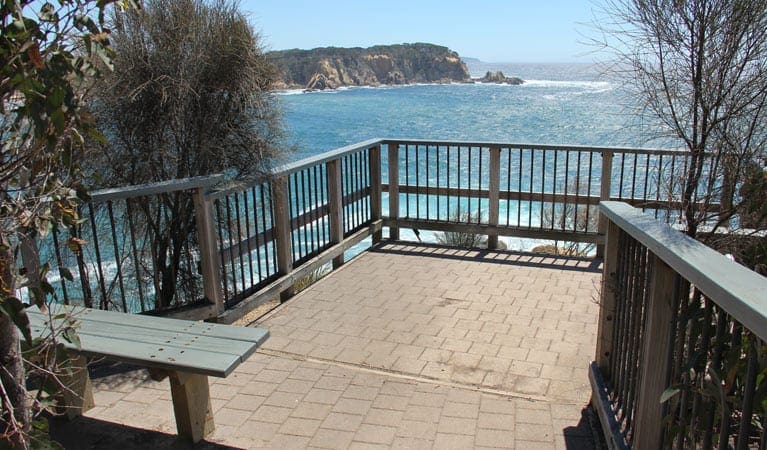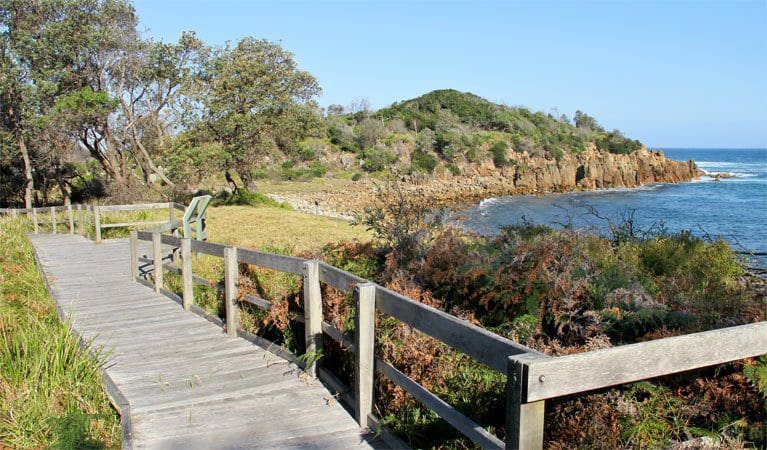Hike at a Glance
Max elevation: 0m
Min elevation: 0m
Total Ascent: 0m
Hike overview
Middle Lagoon walking track leads through beautiful coastal bushland featuring the ancient burrawangs - a cycad that grows abundantly on the south coast of NSW. Just north of Tathra, this short track winds through a diverse range of vegetation to the shore of Middle Lagoon. It's a great spot to bring the family or visitors to introduce them to the natural beauty of the region, with loads of wildlife and great birdwatching.
Wallabies and kangaroos are often seen near the tranquil waters of the lagoon, as well as sea eagles, pelicans and black swans. When you reach the coast, enjoy a refreshing swim or surf. You might see dolphins frolicking in the waves, or perhaps whales during their annual migration.
Retrace your steps and enjoy a leisurely picnic at the nearby tables, or if you're tempted, stay overnight at nearby Middle Beach campground or Myer House.
Tips
Strong rips and currents may be present at the beaches and estuaries within Mimosa Rocks National Park. For more information on staying safe at the beach, see our beach safety page.
There are many patrolled beaches nearby, please see Surf Life Saving Australia.
Visit NSW National Parks and Wildlife Service for more information on this trail.
The longitude and latitude of the start and end points are approximately only and should not be used for navigation purposes. Please contact me if you know the correct coordinates.
Gallery
Got some great shots from this hike? Upload your photos here to inspire others and show off the beauty of the trail!
Click to view form >>
Submitting your photos doesn’t mean you lose ownership. You can be credited for your contributions, and you can request removal at any time.
Content use
Please don’t copy GPX files or content from this site to AllTrails or other platforms. Each trail has been personally mapped, documented, and refined to support Australia’s bushwalking and hiking community. While some details come from land managers, every listing reflects significant personal effort. This is a free, community-driven initiative—your respect helps keep it that way.
Walk map and GPX file
It looks like I don’t have a GPX file for this trail yet. If you have one to share, please email it to me! I’ll verify it against official maps before adding it to help other hikers have a safer, easier experience. Thanks for contributing to a better hiking resource.
Getting there
Getting to the trailhead: Mimosa Rocks National Park.
To Middle Beach carpark. Middle Lagoon walking track is in the central precinct of Mimosa Rocks National Park. To get there, turn east off Bermagui-Tathra Road onto Haighs Road and follow to the end of the road to the carpark. Park entry points Middle Beach carpark See on map Road quality Check the weather before you set out as the road to Middle Lagoon walking track can become slippery when it rains. Parking Parking is available at Middle Beach carpark. It can be a busy place on weekends, so parking might be limited.
Closest towns to this walk: Bega, Cobargo, Eden, Merimbula, Pambula, Tathra
About the region
Located not far from Bega on the far south coast of NSW, Mimosa Rocks National Park offers a great camping holiday. Visit today to go fishing or birdwatching.
Just a short drive from Bega, Mimosa Rocks National Park offers up show-stopping headland views, beaches and pure lagoons, and you'll be spoilt for choice with lookouts, rainforest pockets and historic sites to explore.
The park takes its name from the Paddle Steamer Mimosa that wrecked in 1863 after running onto rocks at the northern end of the park. The rocks of Mimosa have distinctive castle-like features that are the result of intricate folds, faults and intrusions occurring in the rock. For a view you'll never forget, head to Bunga Head for sunrise, the rocks look magnificent backed by the pinks of the early morning sky.
Similar walks nearby
Looking for more walks in or near Mimosa Rocks National Park? Try these trails with a similar difficulty grade.
Track grade
Grade 2 (Easy) - A Gentle Introduction to Inclines: Grade 2 on the AWTGS represents easy walking tracks that offer a slightly more challenging experience compared to Grade 1. Similar to Grade 1, no prior bushwalking experience is required. The track surface is typically hardened or compacted and may have gentle hill sections or occasional steps. The total distance of a Grade 2 walk is typically no greater than 10 kilometers. These walks are still suitable for families with a bit more experience or those seeking a gentle introduction to some inclines.
Explore safe
Plan ahead and hike safely! Carry enough water, pack layers for changing conditions, and bring safety gear like a torch, PLB, and reliable communication device. Check official sources for trail updates, closures, and access requirements, and review local weather and bushfire advice. Most importantly, share your plans with someone before you go. Being prepared makes for a safer and more enjoyable hike! Stay Safe, Explore More, and Always #ExploreSafe.
Packing checklists
What you carry in your pack depends on factors like weather, terrain, and your adventure type. Not sure what to bring? My free planning, food, and packing checklists are a great starting point, covering day hikes, overnight trips, and multi-day adventures. Use them to customise your kit and always prioritise safety.
Let someone know
Before heading out, take a moment to fill out your trip intentions form. It’s a quick way to share your hike details with family or friends. If something goes wrong, they can notify emergency services, ensuring a faster response and peace of mind. Stay safe and enjoy your adventure
Suggest an edit
Spotted a change on this trail? Maybe there are new features, the route has shifted, or the trail is permanently closed. Whatever the update, I’d love your input. Your feedback helps fellow hikers stay informed and ensures that our trail info stays fresh and reliable.
Acknowledgement of Country
Trail Hiking Australia acknowledges the Traditional Owners of the lands on which we hike and pay respects to their Elders, past and present, and we acknowledge the First Nations people of other communities who may be here today.






